
ERMAC v3.0 Banking Malware Source Code Exposed via Weak Password ‘changemeplease’
In a stark reminder of fundamental cybersecurity principles, the complete source code for ERMAC v3.0, an advanced Android banking trojan, has been exposed. This significant breach, uncovered by researchers at Hunt.io, provides unprecedented insight into a sophisticated malware-as-a-service (MaaS) platform. The shocking element? The exposure was due to an incredibly weak password: ‘changemeplease’. This incident underscores the persistent human element in security failures and offers critical lessons for both security professionals and the general public.
The Anatomy of ERMAC v3.0: A Global Threat
ERMAC v3.0 is far from a simplistic piece of malware. Identified as an advanced Android banking trojan, it has demonstrated a remarkable capability to target over 700 financial applications on a global scale. Its primary objective is to surreptitiously intercept credentials, sensitive personal data, and financial information from compromised Android devices. This kind of sophisticated malware-as-a-service operation allows threat actors, even those with limited technical prowess, to launch widespread and debilitating attacks, significantly lowering the barrier to entry for cybercriminals.
The exposure of its source code is a double-edged sword. While it reveals the inner workings of the malware, allowing security researchers to develop more effective countermeasures, it also carries the potential risk of enabling other malicious actors to refine or adapt the existing codebase for new attacks. This underscores the critical need for rapid analysis and dissemination of mitigation strategies.
The ‘changemeplease’ Fiasco: A Preventable Catastrophe
The revelation that access to the ERMAC v3.0 source code was secured by a password as trivial as ‘changemeplease’ is an indictment of basic security practices. This isn’t a complex zero-day vulnerability or a sophisticated supply chain attack. It’s a fundamental error that highlights a pervasive issue in the cybersecurity landscape: human fallibility. Such weak authentication not only compromises the platform itself but also opens the door to understanding its distribution networks, command-and-control infrastructure, and the identities of its operators or clientele.
This incident vividly illustrates the consequences of neglecting basic security hygiene. Weak passwords remain one of the most common vectors for initial access in cyberattacks, leading to devastating data breaches and system compromises. The ease with which Hunt.io gained access should serve as a stark warning to all organizations and individuals managing sensitive data or infrastructure.
Remediation Actions for Individuals and Organizations
While the ERMAC v3.0 source code exposure primarily impacts the criminal operations themselves, the lessons learned are universally applicable. Organizations and individuals must prioritize strong security measures to prevent similar breaches or effectively mitigate the risks posed by such sophisticated banking trojans.
- Implement Strong, Unique Passwords: Mandate and enforce the use of complex, unique passwords for all accounts. Utilize password managers to generate and store these credentials securely. Avoid common phrases or easily guessable combinations.
- Enable Multi-Factor Authentication (MFA): MFA adds a crucial layer of security, making it significantly harder for unauthorized users to access accounts even if a password is compromised. This should be a default security control for all critical systems and user accounts.
- Android Device Security:
- Keep Software Updated: Ensure Android operating systems and all applications are kept up-to-date with the latest security patches. This mitigates known vulnerabilities that malware might exploit.
- Download Apps from Trusted Sources: Only download applications from official app stores (e.g., Google Play Store). Avoid sideloading apps from untrusted or unofficial sources.
- Review App Permissions: Be vigilant about the permissions requested by applications during installation. Exercise caution if an app requests excessive or unnecessary permissions.
- Install Reputable Mobile Security Software: Deploy a trusted mobile security solution that can detect and block malware, phishing attempts, and other mobile threats.
- Employee Training and Awareness: Educate employees about phishing, social engineering tactics, and the importance of strong password practices. A well-informed workforce is a strong line of defense.
- Network Segmentation and Least Privilege: For organizations, segment networks to limit the lateral movement of malware. Apply the principle of least privilege, ensuring users and systems only have access to resources absolutely necessary for their function.
Tools for Detection and Mitigation
Leveraging the right tools is critical in defending against sophisticated threats like ERMAC v3.0.
| Tool Name | Purpose | Link |
|---|---|---|
| Mobile Threat Defense (MTD) Solutions | Real-time threat detection, anomaly detection, and remediation for mobile devices (e.g., Zimperium, Lookout) | Zimperium |
| Endpoint Detection and Response (EDR) | Advanced threat detection, investigation, and response capabilities for endpoints, including mobile devices with appropriate agents (e.g., CrowdStrike, SentinelOne) | CrowdStrike EDR |
| Password Managers | Securely generate, store, and manage complex, unique passwords (e.g., LastPass, 1Password) | LastPass |
| Vulnerability Scanners | Identify and report security flaws in applications and systems (e.g., Nessus, OpenVAS) | Nessus |
| Security Information and Event Management (SIEM) | Centralized logging, correlation, and analysis of security events for threat detection (e.g., Splunk, IBM QRadar) | Splunk SIEM |
Key Takeaways: Lessons from ERMAC v3.0
The exposure of the ERMAC v3.0 source code due to a trivial password is a pivotal moment that offers multiple insights. It highlights the continued dominance of basic security failures as primary attack vectors, even amidst complex cybercriminal operations. For cybersecurity professionals, it provides invaluable intelligence into the mechanics of a prevalent Android banking trojan, enabling the development of more effective detection signatures and mitigation strategies. For the broader public and organizations, this incident is a forceful reminder that vigilance, robust password practices, multi-factor authentication, and continuous security awareness training remain the bedrock of a strong cybersecurity posture. Neglecting these fundamentals, even by sophisticated threat actors, can unravel an entire malicious enterprise.





